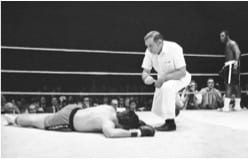Andrew Klumpp is a Ph.D. Student in American religious history in the Graduate Department of Religious Studies at Southern Methodist University.
One of the underappreciated advantages of attending graduate school in a sprawling urban area like DFW has to be that every once and awhile national conferences take place right in your backyard. This past weekend the Society for US Intellectual History (#USIH2017) rolled into town, and when the call for graduate student volunteers went out, I eagerly signed up. On Thursday afternoon, I trekked up to the conference hotel in Plano and immersed myself in the four-day event. By helping at the registration desk, I managed to introduce myself to many of the scholars at the conference, learn about some of the logistics involved in pulling off an event like this, and connect (finally) with people I’ve been chatting with through Twitter’s #twitterstorians for months.
Heading into a busy season of conferencing—the Southern Historical Society is in town in a few weeks and AHA is just around the corner—I did what many academics may be prone to do. A few weeks ago, I headed to the Dallas Public Library and checked out books on how to network effectively. (Keith Ferrazzi’s Never Eat Alone proved particularly useful.) Armed with a fount of new knowledge, I dove into the conference. And, to be honest, it kind of worked. Of course, this was due in part to the size of the conference (around 200 attendees) and the graciousness of many of those in attendance. I managed to hear about fascinating research, get a few leads on archival sources, build relationships with people working on similar projects to my own, and even get one of my books signed by the author (shout out to Andrea Turpin).
Of course, I also attended a spate of engaging panels. The topics ranged from Christian nationalisms in the Early Republic—which included an excellent paper by SMU’s Kate Carté Engel—to grassroots birth control advocates and explorations of resonances between social and fiscal conservatism in the late twentieth century. One of the most thought-provoking questions that undergirded many sessions queried what counts as intellectual history and what kinds of sources might inform it. Are the ideas of self-proclaimed intellectuals necessarily more systematic and consistent than those of everyday folks? If we think so, what might that say about our views of everyday people and their role in intellectual history? If not, what might that mean for the need to reevaluate complex intellectual figures, such as Ralph Waldo Emerson? At times, these questions bubbled up in lively question and answer sessions, but more often, they simmered in enriching ways beneath the surface of the conversation.
This conference also piloted a new “Guided Discussion” session format. More interactive than a traditional roundtable, in this model the four panelists each briefly posed a question to the group around a common theme—in this case, how historians use words with contested or complex meanings. After each panelist posed his or her particular question, the audience broke into groups based on which question each person wanted to ponder and then discussed it with their small group. My group consisted of a historian of religion (me), a historian of science, a historian of disability and two philosophers. This proved to be a remarkably fruitful discussion of terminology. It shone light on the assumptions that particular subfields bring to certain terms and parsed the tensions involved in using terminology that reflects our sources while also attempting to be precise and avoid terms now deemed offensive. Did we solve the underlying problem? Certainly not! Yet, these varying voices did push me to consider my own use of language and to sharpen my own practices when using contested concepts.
On Saturday evening, Annette Gordon-Reed delivered an outstanding keynote address to a packed crowd. She focused her remarks on how memories kept alive the stories of Thomas Jefferson’s relationship Sally Hemmings—an enslaved woman owned by Jefferson. Gordon-Reed recounted her own work to uncover this relationship and how it relied on taking seriously the memories of Hemmings’ children. What is more, she explored how the memories of Hemmings’ children and their descendants shed light onto the relationship between Hemmings, Jefferson and their children. In a spirited question and answer session, Gordon-Reed deftly engaged questions that ranged from how Jefferson ought to be commemorated to how to label relationships between white men and enslaved women.
As the weekend drew to a close, I came to appreciate the privilege of having such an excellent conference take place right here in Dallas. As a native of a hamlet in Northwest Iowa, I’m admittedly rather unfamiliar with national organizations showing up in town—aside from glad-handing presidential candidates, of course. I can, however, now tell you from experience that I’d rather shake hands with a crowd of intellectual historians than road-weary politicians any day.




